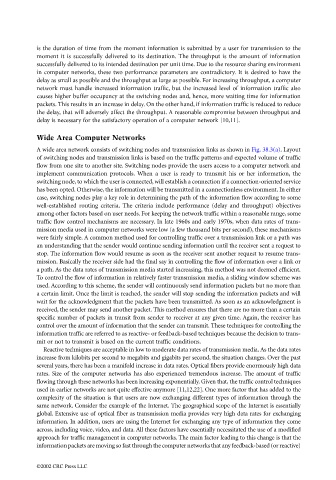Page 1075 - The Mechatronics Handbook
P. 1075
is the duration of time from the moment information is submitted by a user for transmission to the
moment it is successfully delivered to its destination. The throughput is the amount of information
successfully delivered to its intended destination per unit time. Due to the resource sharing environment
in computer networks, these two performance parameters are contradictory. It is desired to have the
delay as small as possible and the throughput as large as possible. For increasing throughput, a computer
network must handle increased information traffic, but the increased level of information traffic also
causes higher buffer occupancy at the switching nodes and, hence, more waiting time for information
packets. This results in an increase in delay. On the other hand, if information traffic is reduced to reduce
the delay, that will adversely affect the throughput. A reasonable compromise between throughput and
delay is necessary for the satisfactory operation of a computer network [10,11].
Wide Area Computer Networks
A wide area network consists of switching nodes and transmission links as shown in Fig. 38.3(a). Layout
of switching nodes and transmission links is based on the traffic patterns and expected volume of traffic
flow from one site to another site. Switching nodes provide the users access to a computer network and
implement communication protocols. When a user is ready to transmit his or her information, the
switching node, to which the user is connected, will establish a connection if a connection-oriented service
has been opted. Otherwise, the information will be transmitted in a connectionless environment. In either
case, switching nodes play a key role in determining the path of the information flow according to some
well-established routing criteria. The criteria include performance (delay and throughput) objectives
among other factors based on user needs. For keeping the network traffic within a reasonable range, some
traffic flow control mechanisms are necessary. In late 1960s and early 1970s, when data rates of trans-
mission media used in computer networks were low (a few thousand bits per second), these mechanisms
were fairly simple. A common method used for controlling traffic over a transmission link or a path was
an understanding that the sender would continue sending information until the receiver sent a request to
stop. The information flow would resume as soon as the receiver sent another request to resume trans-
mission. Basically the receiver side had the final say in controlling the flow of information over a link or
a path. As the data rates of transmission media started increasing, this method was not deemed efficient.
To control the flow of information in relatively faster transmission media, a sliding window scheme was
used. According to this scheme, the sender will continuously send information packets but no more than
a certain limit. Once the limit is reached, the sender will stop sending the information packets and will
wait for the acknowledgment that the packets have been transmitted. As soon as an acknowledgment is
received, the sender may send another packet. This method ensures that there are no more than a certain
specific number of packets in transit from sender to receiver at any given time. Again, the receiver has
control over the amount of information that the sender can transmit. These techniques for controlling the
information traffic are referred to as reactive- or feedback-based techniques because the decision to trans-
mit or not to transmit is based on the current traffic conditions.
Reactive techniques are acceptable in low to moderate data rates of transmission media. As the data rates
increase from kilobits per second to megabits and gigabits per second, the situation changes. Over the past
several years, there has been a manifold increase in data rates. Optical fibers provide enormously high data
rates. Size of the computer networks has also experienced tremendous increase. The amount of traffic
flowing through these networks has been increasing exponentially. Given that, the traffic control techniques
used in earlier networks are not quite effective anymore [11,12,22]. One more factor that has added to the
complexity of the situation is that users are now exchanging different types of information through the
same network. Consider the example of the Internet. The geographical scope of the Internet is essentially
global. Extensive use of optical fiber as transmission media provides very high data rates for exchanging
information. In addition, users are using the Internet for exchanging any type of information they come
across, including voice, video, and data. All these factors have essentially necessitated the use of a modified
approach for traffic management in computer networks. The main factor leading to this change is that the
information packets are moving so fast through the computer networks that any feedback-based (or reactive)
©2002 CRC Press LLC

